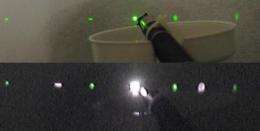Researchers measure high infrared power levels from some green lasers

Green laser pointers have become a popular consumer item, delivering light that's brighter to the eye than red lasers, but stories have circulated on the Web about the potential hazards of inexpensive models. Now, a team led by physicist Charles Clark at the National Institute of Standards and Technology puts some numbers to the problem. In one case, the group found that a green laser pointer emitted almost twice its rated power level of light -- but at invisible and potentially dangerous infrared wavelengths rather than green. A new NIST technical note* describes the nature of the problem as well as a home test using an inexpensive webcam that can detect excess infrared light from green lasers.
Late last year, the research team purchased three low-cost green laser pointers advertised to have a power output of 10 milliwatts (mW). Measurements showed that one unit emitted dim green light but delivered infrared levels of nearly 20 mW—powerful enough to cause retinal damage to an individual before he or she is aware of the invisible light. NIST's Jemellie Galang and her colleagues repeated the tests with several other laser pointers and found similarly intense infrared emissions in some but not all units.
The problem stems from inadequate procedures in manufacturing quality assurance, according to the research team. Inside a green laser pointer, infrared light from a semiconductor diode laser pumps infrared light at a wavelength of 808 nm into a transparent crystal of yttrium orthovanadate doped with neodymium atoms (Nd:YVO4), causing the crystal to lase even deeper in the infrared, at 1064 nm. This light passes through a crystal of potassium titanyl phosphate (KTP), which emits light of half the wavelength: 532 nm, the familiar color of the green laser pointer.
However, if the KTP crystal is misaligned, little of the 1064 nm light is converted into green light, and most of it comes out as infrared. Excess infrared leakage can also occur if the coatings at both ends of the crystal that act as mirrors for the infrared laser light are too thin.
The NIST team says this problem could be solved by incorporating an inexpensive infrared filter at the end of the laser, which could reduce infrared emissions by 100-1000 times depending on quality and cost. Although these filters exist in modern digital cameras and more expensive green laser pointers, they often are left out of the inexpensive models.
The team demonstrates a home test that laser hobbyists could conduct to detect excessive infrared leakage, by using a common digital or cell phone camera, a compact disc, a webcam and a TV remote control. Regardless, they say owners of the devices should never point the lasers at the eyes or aim them at surfaces such as windows, which can reflect infrared light back to the user—a particularly subtle hazard because many modern energy-saving windows have coatings designed specifically to reflect infrared.
More information: * J. Galang, A. Restelli, E.W. Hagley and C.W. Clark, NIST Technical Note (TN 1668), A Green Laser Pointer Hazard (July 2010) Available on-line at www.nist.gov/manuscript-public … ch.cfm?pub_id=906138
Provided by National Institute of Standards and Technology


















